The Time Keeper
By Kevin McGue
Swiss-made wristwatches have long been known for precision, craftsmanship and reliability. So famed is Switzerland for its timepiece exports that one could almost be forgiven for thinking that watches aren’t made in any other country. However, with longevity, technological perfection, and innovative design, Japanese-made watches have much to offer its European rivals.
Royal Orient
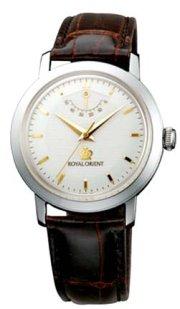 Royal Orient’s WE0031EG model. The small dial in the upper portion of the face indicates how many hours remain before the watch needs to be wound again. While Seiko and Casio were expanding their shares in the burgeoning quartz watch market in the 1970s, the younger Orient Watch Company (www.orient-watch.jp) maintained a more traditional approach with its Royal Orient line, launched in 1959.
Royal Orient’s WE0031EG model. The small dial in the upper portion of the face indicates how many hours remain before the watch needs to be wound again. While Seiko and Casio were expanding their shares in the burgeoning quartz watch market in the 1970s, the younger Orient Watch Company (www.orient-watch.jp) maintained a more traditional approach with its Royal Orient line, launched in 1959. 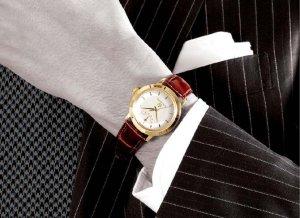 The Royal Orient line of watches has maintained classic styling over the years The line features fully analog, hand-wound mechanisms running 50 hours on a single wind, and classic design features such as highly readable, simple faces and durable leather bands. With prices ranging from 136,500 yen to 420,000 yen, Royal Orient offers a highly affordable alternative to Swiss-made analog watches. For those who would like a bit of a rebellious touch around their wrist, Orient Star’s Retro-Future line offers watches in the 65,000 yen to 75,000 yen range, based on classic motorcycle watches and futuristic designs of cameras of the 1950s.
The Royal Orient line of watches has maintained classic styling over the years The line features fully analog, hand-wound mechanisms running 50 hours on a single wind, and classic design features such as highly readable, simple faces and durable leather bands. With prices ranging from 136,500 yen to 420,000 yen, Royal Orient offers a highly affordable alternative to Swiss-made analog watches. For those who would like a bit of a rebellious touch around their wrist, Orient Star’s Retro-Future line offers watches in the 65,000 yen to 75,000 yen range, based on classic motorcycle watches and futuristic designs of cameras of the 1950s.
Seahope
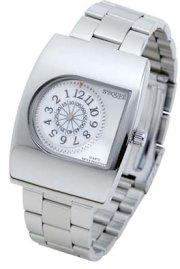 Seahope’s “Roulette” model looks traditional, but actually the face dials rotate while the time indicator remains stationary.If you are looking for something completely non-traditional, Seahope (www.seahope.com) offers the type of truly innovative watch that can only be found in Japan. Challenging the notion that the traditional two-dial display is the best interface for communicating the time,
Seahope’s “Roulette” model looks traditional, but actually the face dials rotate while the time indicator remains stationary.If you are looking for something completely non-traditional, Seahope (www.seahope.com) offers the type of truly innovative watch that can only be found in Japan. Challenging the notion that the traditional two-dial display is the best interface for communicating the time, 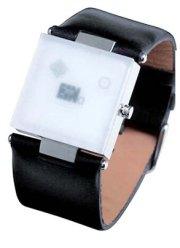 Shunning traditional hands, Seahope’s “Mist” model features an hour square and a minute circle. Seahope designers are constantly pushing the boundaries of watch design. The “Orbit” model features two ovals at odd angles. White spheres move through the ovals, like planets tracing their orbit, indicating the hour and minute. The “Mist” model features a circle and square moving behind a thick piece of frosted glass to indicate the hour and minute. The “Wheel” model features radial spokes that gradually fill in from the center outwards to indicate the time. The “Lines” model displays the time in an abstract, yet intuitive grid pattern. Moderately priced in the 10,000 yen to 20,000 yen range, these are ideal for collectors who are constantly changing watches to suit their moods and attire.
Shunning traditional hands, Seahope’s “Mist” model features an hour square and a minute circle. Seahope designers are constantly pushing the boundaries of watch design. The “Orbit” model features two ovals at odd angles. White spheres move through the ovals, like planets tracing their orbit, indicating the hour and minute. The “Mist” model features a circle and square moving behind a thick piece of frosted glass to indicate the hour and minute. The “Wheel” model features radial spokes that gradually fill in from the center outwards to indicate the time. The “Lines” model displays the time in an abstract, yet intuitive grid pattern. Moderately priced in the 10,000 yen to 20,000 yen range, these are ideal for collectors who are constantly changing watches to suit their moods and attire.
Grand Seiko
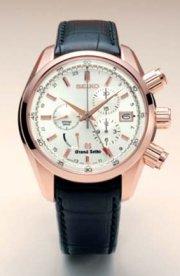 Grand Seiko’s SBGC004 model features a pink gold casing and a bold face design. Seiko launched its “Grand Seiko” line (www.seiko-watch.co.jp/gs/) in 1960 with the specific goal of giving Japan a position in the luxury watch market, which at that time was fully monopolized by Switzerland. In 1970, Seiko released the world’s first quartz watch, and soon followed with the first quartz chronograph (a watch with both timekeeping and stopwatch functions). In the ‘80s, the Grand Seiko line was phased into quartz-driven technology, creating a watch with the appearance of an analog timepiece, but with timekeeping accuracy within 10 seconds per year.
Grand Seiko’s SBGC004 model features a pink gold casing and a bold face design. Seiko launched its “Grand Seiko” line (www.seiko-watch.co.jp/gs/) in 1960 with the specific goal of giving Japan a position in the luxury watch market, which at that time was fully monopolized by Switzerland. In 1970, Seiko released the world’s first quartz watch, and soon followed with the first quartz chronograph (a watch with both timekeeping and stopwatch functions). In the ‘80s, the Grand Seiko line was phased into quartz-driven technology, creating a watch with the appearance of an analog timepiece, but with timekeeping accuracy within 10 seconds per year.
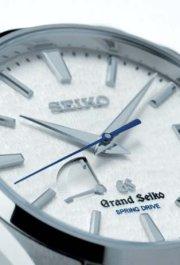 The Grand Seiko line features a self-winding spring drive. It is automatically “recharged” as it moves on the user’s wrist.
The Grand Seiko line features a self-winding spring drive. It is automatically “recharged” as it moves on the user’s wrist.
In the meantime, fully analog Swiss-made watches maintained their longstanding popularity in Japan. In response, Seiko developed for the new millennium a new spring-drive chronograph that married traditional analog components with digital technology. The self-winding spring-drive runs smoothly for three days (72 hours) when fully wound, as opposed to the approximately 40 hours that is standard on fully mechanical pieces. The remaining power reserve is displayed on all models, and the watch simply needs to be worn in order to wind the drive. The spring-drive powers the wheels as well as generating power for a tiny crystal oscillator that regulates movement with even higher accuracy than quartz. The spring drive line was released worldwide in 2005, becoming the first luxury Japanese-made watch to enter the global market. Prices range from 450,000 yen for a smart, durable stainless steel model, to 2.8 million yen for a truly lavish model with an 18- carat pink gold case, and leather band.
Citizen Campanola
If you cannot find a watch that truly matches your taste, you might want to look into getting a build-to-order watch from Citizen’s Campanola line. Available at the Tobu Department store in Ikebukuro, Tokyo and the Daimaru store in Shinsaibashi, Osaka, this unique watch line is highly customizable. Using a special computer, shoppers build a virtual 3D model of their ideal watch by selecting from 12 types of watch faces, four types of outer rings, 32 varieties of hands, and seven options for bands, adding up to a total of 10,752 possible variations. When everything is satisfactory, the order is placed, and the finished watch is delivered in around one month. Prices range from 336,000 yen to 357,000 depending on the options chosen.






Comments
Andrew (not verified)
April 16, 2009 - 04:38
Permalink
Japanese watches
I saw some wacky Japanese watches in Europe at pamparampa
Perhaps worth seeing...